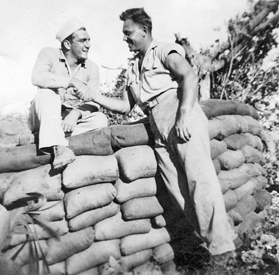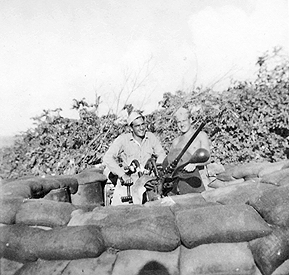The Stamford Historical Society Presents
Pride and Patriotism: Stamford’s Role in World War II
Online Edition
The Interviews
Jack Palmer
Jack Palmer joined the Marines in 1942 and was shipped out that same year to Samoa. He spent his career helping to secure and defend the islands of the South Pacific. He was personally involved in the Peleliu/Angaur campaigns in the Palau Island group, which came to be known as Operation Stalemate because of the length and cost of this battle.
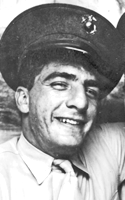 I graduated Stamford High School in 1938. Everyone was itching to go over to fight.
I joined the Marines in 1942. I went to New York to join. Then we went through Boot Camp, and I was overseas in 1942 already. I went to Parris Island for training, then to Camp Pendleton, California. Boot Camp was two months, it was rough. They had to teach us everything in two months…marching, target practice, the use of a bayonet…then we went to Samoa…it took 31 days to get there. We zigzagged and we were in convoy. There were a few thousand men on the ship.
I graduated Stamford High School in 1938. Everyone was itching to go over to fight.
I joined the Marines in 1942. I went to New York to join. Then we went through Boot Camp, and I was overseas in 1942 already. I went to Parris Island for training, then to Camp Pendleton, California. Boot Camp was two months, it was rough. They had to teach us everything in two months…marching, target practice, the use of a bayonet…then we went to Samoa…it took 31 days to get there. We zigzagged and we were in convoy. There were a few thousand men on the ship.
I was in the 7th Marine Defense Battalion, attached to 1st or 5th Marines or whoever was stationed there. As soon as they took an island and secured it, we would defend it. I was on a lot of islands.
When we went to Samoa it was a peaceful island. We trained more there and got ready for battle. We had one alert even on Samoa…no bombs, just an alert. We were on American Samoa...it was a very nice island and the people were very friendly…we took off from there
We were training all the time, especially how to land…LSTs on the beach. I was very afraid of heights. The cargo nets off the boats were very high so I would get into the net with my eyes closed. The ship would be bouncing and I did it with my eyes closed.
The coral was very sharp, when you climbed the coral you would get all cut up. I did that with my eyes closed too, too high… there were mountains of coral on the islands…it was sharp. The LSTs often got stuck on coral or the bottoms got ripped out. I had to wade ashore a number of times. The two battles I that I saw were Peleliu and Angaur.
We stopped at every island that was taken…we would stay a few days or weeks…we went island to island, Guadalcanal, Wake…etc. …but most were taken at the time. I was not in the battles…I was on all the islands…on Angaur, when you ate your rations, you had to constantly beat away the flies. I must have eaten thousands of them. It was hard to completely clear an island, as the Japanese had dug in so deeply and used caves and tunnels.
We went to Palau group and there we stayed we went into battle for that one. This was in the Palau group at Peleliu and Angaur. Our battalion was to go in with the Army 101 at Angaur…that was a bitter battle. We were not the first wave…battles still going on though. I saw dead Marines…guys getting shot at…we were getting shot at…first time I saw rockets and flamethrowers…they would burn them out. I thought no one could survive that, but they did.
Once in a while you would see Jap troops up in the trees. Once I was carrying a wounded Marine with a priest and he got shot in the hand by a Jap sniper…they were shooting at us…I didn’t get wounded. I never got wounded by a shot, but I was wounded a few times…I got rust in my eye and had to go to hospital for a couple days. Palau was the big battle for me…I saw most of the South Pacific islands...they all looked the same.
Almost all islands I landed on were secure…except Palau…Anguar and Palau…Peleliu…that was the main battle…the battle was around 1944. I was in the zone most of my career in the Marines…I was trained as a gunner working with machine guns. The first thing you did once you landed on an island was dig a foxhole and set up the gun. Each gun had its own place.
Most of the islands still had Japs on them even after they were secure…Japs were still down deep…only needed to defend and maintain island. We did root them out…I was a machine gunner on a 30caliber machine gun…The gun shot 600 bullets a minute.
They attacked us a lot at night…They would shout: “Haikai Malingi” –eat shit Marine! They would also scream “Banzai!” But there wasn’t always an attack.
They would have to use a password at night to get into camp…they tried to get in…
We shot in the direction of fire…we knew where they were and you could hear it on the rocks/coral but you couldn’t see them. I didn’t take prisoners but other Marines brought some in. I remember looking at some of the prisoners…
When you did something the Japs didn’t expect, they didn’t know what to do…as long as you did what was expected they were good fighters.
We were sleeping in the foxholes near the guns when we defended the islands. Soon as you got into an island you dug foxholes.
I was with the same battalion the whole time until I returned to the States to go to Brunswick, Maine for training….training on the M1 rifle – we had Springfields before…M1 was better rifle… later took that away and gave us carbines…light rifle good for South Pacific.
I did get ill on the boats… We missed milk and pizza.
7th Defense Battalion attached to 1st Marines and later 5th Marines.
I came home before war’s end, I was in camp Pendleton when the war ended…ready to ship out again… I went into the reserve at that point.
Photos Courtesy Jack Palmer
The Battle of Angaur
The Battle of Peleliu
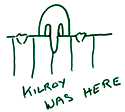 Introduction
Introduction
Veterans
Battles
Stamford Service Rolls
Homefront
Exhibit Photos
Opening Day


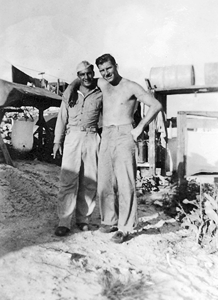
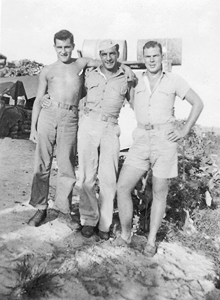
 Introduction
Introduction I graduated Stamford High School in 1938. Everyone was itching to go over to fight.
I joined the Marines in 1942. I went to New York to join. Then we went through Boot Camp, and I was overseas in 1942 already. I went to Parris Island for training, then to Camp Pendleton, California. Boot Camp was two months, it was rough. They had to teach us everything in two months…marching, target practice, the use of a bayonet…then we went to Samoa…it took 31 days to get there. We zigzagged and we were in convoy. There were a few thousand men on the ship.
I graduated Stamford High School in 1938. Everyone was itching to go over to fight.
I joined the Marines in 1942. I went to New York to join. Then we went through Boot Camp, and I was overseas in 1942 already. I went to Parris Island for training, then to Camp Pendleton, California. Boot Camp was two months, it was rough. They had to teach us everything in two months…marching, target practice, the use of a bayonet…then we went to Samoa…it took 31 days to get there. We zigzagged and we were in convoy. There were a few thousand men on the ship.